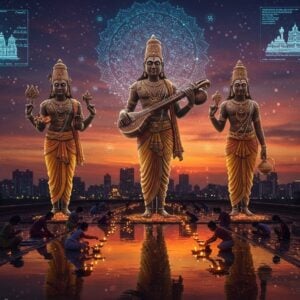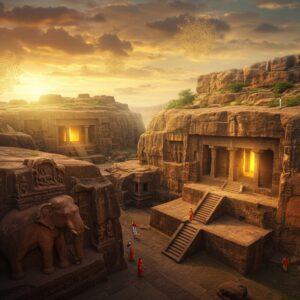
The Dogra region, nestled in the breathtaking lower Himalayan ranges of Jammu, is a land where history whispers through the valleys and culture dances in the vibrant hues of its art. This region, shaped by majestic mountains, whispering forests, and the flowing rivers, offers a captivating blend of traditions and artistic expressions, a true tapestry of heritage waiting to be explored. For those seeking to connect with the heart of India’s rich cultural heritage, the Dogra region offers a truly enriching experience.
A Land of Diverse Influences
Dogra culture isn’t monolithic; it’s a beautiful mosaic formed by the convergence of various castes and tribes over centuries. This has created a secular and harmonious society where different lifestyles and traditions coexist, enriching the cultural landscape. This vibrant mix is what makes the Dogra identity so unique and fascinating. It’s a testament to the power of unity in diversity, a principle deeply embedded in Indian culture.
Language: The Heart of Dogra Identity
At the heart of Dogra identity lies Dogri, their own language, officially recognized in the Indian Constitution on December 22, 2003. Derived from the ancient Sanskrit, Dogri is more than just a language; it’s a vessel carrying the region’s history, stories, and cultural nuances. Its recognition is a matter of great pride for the Dogra people and a symbol of their distinct cultural identity.
The Rhythms of Dogra Life: Performing Arts
The performing arts of the Dogra region are a vibrant expression of its soul. Folk music and dance, deeply intertwined with the rhythms of daily life, are prominent in Dogra culture. From the energetic Dheku and Phummani to the spiritually charged Jagarana and the graceful Chhajja, Kuddha, and Hirana, these dances tell stories of love, devotion, and everyday life.
Beyond dance, folk theatre thrives in forms like Bhagtan, Raas, and Chandrauli, narrating ancient tales and passing down wisdom through generations. And while classical music isn’t a traditional form here, the unique styles of Kaarak and Bhaakh hold a special place, adding another layer to the region’s rich musical tapestry.
Visual Arts: A Feast for the Eyes
The Dogra region is a treasure trove of visual arts. Miniature paintings, especially the Pahari style that flourished in the late 17th century, are a testament to the region’s artistic finesse. The Kangra Kalam, Chamba Kalam, Basohli Kalam, Poonch Kalam, and Jammu Kalam schools, each with its distinctive characteristics, are a visual delight. The palaces of Ram Nagar, Riyasi, Jasrota, and Basohli, adorned with breathtaking mural paintings depicting mythological themes, offer a glimpse into the region’s rich artistic heritage.
The Dogra Art Museum, housed in the historic Mubarak Mandi complex in Jammu, is a must-visit for art enthusiasts. Established in 1954, it houses a magnificent collection of over 7,000 objects, including exquisite Pahari miniature paintings, particularly from the Basohli school, along with Dogra costumes, sculptures, coins, manuscripts, and more. It’s a journey through the artistic heart of the Dogra region, a place where history and art intertwine.
Handicrafts also flourish here, with weaving, woodwork, and block-printing adding to the region’s artistic charm. These traditional crafts are not just a source of livelihood but a way of life, preserving ancestral skills and adding to the cultural richness of the region. These beautiful handicrafts are often used in religious ceremonies, adding a touch of tradition and artistry to spiritual practices.
Looking for authentic puja items to enhance your spiritual practices? Poojn.in offers a wide selection of high-quality baran dala sets, kumkum, and hawan samagri, all crafted with utmost care and reverence. Enhance your spiritual experience with these sacred items from Poojn.in.
Values: The Soul of Dogra Culture
At the heart of Dogra culture lies “Dogriyat,” a philosophy of “Live and let live.” This essence embodies the values of patriotism, amity, unity, patience, sacrifice, and secularism. It’s a way of life that promotes harmony and respect, reflecting the peaceful coexistence of diverse communities within the region.
Cuisine: A Culinary Journey
Dogra cuisine is another delightful aspect of the region’s culture. Khatta Meat, a tangy mutton dish cooked with pomegranate seeds or lime juice and infused with the smoky aroma of mustard oil-soaked charcoal, is a local specialty. “Taam,” a traditional Dogra feast, is more than just a meal; it’s a ritualistic and community-driven experience, showcasing the values of purity, simplicity, and togetherness. It’s a celebration of community bonds and a testament to the importance of sharing and togetherness in Dogra culture.
Traditional Attire: A Tapestry of Colors
The traditional Dogra attire is a visual delight, reflecting the region’s rich artistic heritage. From the elegant Pagris and Churidar Pajamas to the flowing Southans, Achakans, and embroidered Kurtas, and the vibrant Chunnies and Kameez, each garment tells a story of tradition and cultural pride. These traditional dresses are not just clothing; they are a symbol of identity, connecting the present generation to their ancestors and their rich heritage.
Entertainment: From Ancient to Modern
Historically, Dogra entertainment included dicing, music, dance, games, festive gatherings, storytelling, and hunting. While these traditional forms continue to be cherished, modern entertainment like cinema and television has also found its place. This blend of old and new reflects the evolving nature of Dogra culture, embracing the present while honoring the past. This adaptation ensures that Dogra culture remains vibrant and relevant, connecting generations through shared experiences.
The Dogra culture, a vibrant and evolving tapestry, is a testament to the region’s rich history, geography, and social values. It’s a journey of discovery, offering a glimpse into the heart of India’s diverse cultural landscape.
Deepen your connection with Indian spirituality. Poojn.in offers a curated collection of divine murtis, including exquisite brass Laddu Gopal and Goddess Tara statues. Bring home the blessings and create a sacred space for worship with these beautiful murtis from Poojn.in.
You can explore more about Indian culture and traditions in these related articles:


